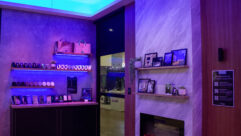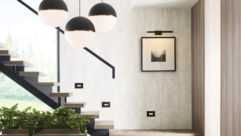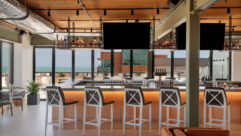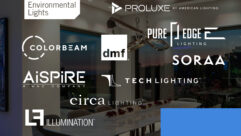
Illuminating Worship: Lighting for Portable Churches, Part 1
Apr 14, 2011 12:00 PM,
with Bennett Liles
Listen to the Podcasts
Editor’s note: For your convenience, this transcription of the podcast includes timestamps. If you are listening to the podcast and reading its accompanying transcription, you can use the timestamps to jump to any part of the audio podcast by simply dragging the slider on the podcast to the time indicated in the transcription.
Churches have made a lot of progress on their sound, projection, and even streaming their services, but lighting is still a big challenge, especially for the portable church. Greg Persinger of church lighting firm Vivid Illumination is here to provide some tips for selecting lighting gear and using it the right way. That’s coming up next on the SVC podcast.
Greg thanks for being with me on the SVC podcast and we’re going to be talking about lighting for portable churches today, and just the sound of that suggests a challenge. A portable church can be just about anything you can come up with from something that barely looks like an assembly at all right up to very professional-looking setups and your company Vivid Illumination takes on this job and of course there’s certainly no ambiguity in that name. Does Vivid Illumination specialize in portable churches or do you light corporate events and other things?
Well Bennett first I want to say thanks a lot for having me on the podcast today. It’s an honor to be here with you. Vivid Illumination, we specialize in churches but not necessarily portable churches. We do all types of churches, we also do some live events and also corporate theater, educational theater—different things like that. We still do a lot of design and consulting in all different areas but portable churches are something that’s came to light. I have ten-year touring background as a lighting guy before moving over to the design and consulting side, and so whenever people talk about portable churches that’s near and dear to my heart with the touring background that I have. [Timestamp: 2:04]
Yeah, a touring background could really come in handy because it’s basically a touring church with the same production elements.
It really is.
In fact a lot of these churches I figured they just meet in the same place all the time but some of them have to move around quite a bit but lighting can obviously go a long way toward setting the right atmosphere regardless of the location. You’ve been doing this for a while, how long has Vivid Illumination been around as a company?
As a company, since 2000. I was a freelancer before that but in 2000 I made it official. [Timestamp: 2:37]
Well you’ve had some time to establish your own identity with that. I guess when you get called in for a church lighting job you probably see the same things going wrong most of the time. What’s the most common mistake you see being made by portable churches or I guess even permanent churches making when it comes to lighting?
That’s an easy one, not planning ahead…not creating a plan—just jumping into it and not knowing exactly what they’re going to do and trying to buy pieces of equipment and then after the fact make it all integrate or after the fact decide whether or not they have enough power or the right hang positions or whether the lighting fixtures were the correct fixtures to buy. I see people get really excited about their project and we want people to be excited about their project but we want them to have a little bit of…temper that excitement with some preplanning to make sure that they’re spending their money wisely and making the correct choices that are actually going to have a positive impact on their assembly instead of a negative impact. [Timestamp: 3:4]
Yeah I guess instead of carefully figuring up their power needs and power availability they probably do it in reverse order and just run out buy equipment.
Yeah and I say this a little tongue in cheek…I don’t want to ruffle the feathers of any of my audio or video friends but everybody can do audio and everybody can do video but lighting is a little bit of black magic voodoo. And what I mean in that is you might not do audio well but if you know that you have a five-piece band and three backup singers you know that it…you know you’re at least going to have at least ten or twelve microphones depending on whether you’re micing the drums and that sort of thing. And most church people they can add that up and they get that and then they know that they need that many channels at least on their snake and they know they need some speakers and they know they need a mixing console and all of that. And they can kind of figure out what they need. They might not pick good pieces of equipment but they can figure out the basics and same with a video projector, “OK, I’m going to do two screens,” it’s pretty obvious you need two projectors. You might not have big enough, bright enough projectors but at least you know you need two projectors. But when you walk into a space and you go, “Wow I have a 30ft.-wide stage that’s 18 feet deep,” it’s pretty hard for people to go, “Well I need ten fixtures of this type to light that,” or “I need eight fixtures,” or so on and so forth. So it’s a little bit harder…lighting is a little more of an unknown for most people. [Timestamp: 5:12]
Yeah in some ways it’s a lot more subjective than sound or video and you can shift the whole atmosphere with some relatively subtle effects. Now the portable churches, they go to some places where they may already have lights but maybe they’re not allowed to use them through liability concerns or whatever. Do you sometimes have to go in and set up lighting in addition to or say on top of what’s already there?
A lot of the portable churches that I’ve seen they either meet in a school cafeteria, a gymnatorium, my church here in Nashville—we actually have one portable church campus that meets in a high school theater but unfortunately that high school theater—it’s an old theater and it was never really well-outfitted to begin with and so the school actually borrows our lighting gear whenever they do a school play because the school really doesn’t have any resources. So even though we’re in a theater we had to put in a small lighting system to augment what the school owned because the school’s equipment was almost non-existent. So a lot of times the church when they’re coming in…it depends on what’s their existing and what they can negotiate with the building that they’re renting to use but a lot of times they end up taking everything in themselves. [Timestamp: 6:36]
Well of course when you do that it pays to be as organized as possible and know what you have and what it can do. What are the primary components to portable church lighting?
The primary components are power, it’s your lifeblood; your control, how are you going to control everything; your hang positions, what are you going to hang your fixtures from, and then your lighting fixtures themselves. Those are the four primary components of lighting. [Timestamp: 7:01]
Illuminating Worship: Lighting for Portable Churches, Part 1
Apr 14, 2011 12:00 PM,
with Bennett Liles
And of course lighting always co-exists with sound and in many cases with video and projection. So would there be one production element that potentially causes the most trouble with lighting—say maybe projection?
Typically that is projection. Typically the video guys, they get a little angry with you whenever you put a lot of light on their video screen and wash it out and so you’re typically working really hard to keep the amount of ambient light off of that projection screen. We co-exist pretty well with the audio guys, but the videos guys, it sometimes it can be a big love/hate relationship. [Timestamp: 7:37]
And as I said lighting is more subjective and it can be interrupted differently by different people. I guess the pastors’ opinion carries the most weight most of the time. Do you find them sometimes favoring aesthetics, say not having equipment showing rather than maybe allowing lights to be placed where they need to be for a maximum effect?
Most of the portable churches that I have seen are more contemporary so in a more contemporary portable church the aesthetic doesn’t really play a whole lot into it. They want everything to be neat and inviting whenever you walk into the room—they don’t want it to be cables just thrown everywhere and stuff for people to trip on and things like that but the aesthetic, seeing the equipment and things like that is not an issue for most portable churches. Part of that is just the reality that if you can’t permanently mount equipment, you’re going to see it. Now in a permanent installation it’s kind of the same holds true, in a more contemporary church the aesthetic—seeing the equipment is not such a big deal but in a more traditional church it typically is a big deal and then in that case it depends on who’s driving the project. A lot of times if the pastor’s driving the project he’s not as…quite as concerned with seeing equipment. If it’s…more of the media guys and things like that driving the project then you tend to find that the boards that are making the decisions, the ways and means people and the building committee, they’re much more concerned with, “Hey, how’s this all going to look?” and that sort of thing—especially in a really pretty traditional cathedral-style church. They’re all of us concerned about how it’s going to look and rightfully so. [Timestamp: 9:25]
Yeah for a younger, more contemporary congregation I guess the gear being out there may just add to the atmosphere like it being a show or a concert event. In setting this up though, what’s the best way to hang lighting for say a medium-sized, maybe a 600-seat venue, where there’s nothing built in for lighting.
From a portable church standpoint you’re looking at more of some type of crank-up lift kind of device. There’s a couple of different companies, of course Genie being the de-facto standard, everybody in the production industry has probably used a Genie lift at one time or another on a project but there are some other companies that have really great crank up lifts as well that don’t take up quite the same space that a Genie lift does. Applied Electronics has a couple of really neat lifts that I really like for portable church use because they’re smaller and they’re lighter weight. They don’t have the weight capacity that a Genie has but typically in a portable church you’re not trying to hang as much as you would if you’re trying to do a rock show or something like that. So that’s typically what you’re going to do. Pipe in base, putting a ten or 12ft. pipe on a 50lb. base—you see that a lot also doing 12in. box truss on bases that works really well too. I’ve seen people do 16ft.…20ft. towers depending on the size of the room so there’s a few different options. If we were talking about a permanent installation that really gets determined by the structure—what kind of structure do you have above the ceiling, do you have I-beams and what’s their spacing. That kind of thing but in a portable church it’s all got to be put up and taken down every week. So we’re always looking for things that we can adapt from the touring industry so that we can bring it in, set it up quickly, hang the lights, focus them and then at the end of the day we can pull it all down and pack it back up in a truck or trailer and drive it off. [Timestamp: 11:34]
Right and sometimes being put up and taken down by different people than the ones who were doing it last week. Do you see some portable churches maybe trying to do that’s beyond the capability of the gear they have?
Boy that’s a loaded question in a way. I guess one of the answers to that would be yes, they try to do more production beyond the capability of the gear but I typically find that it’s that way because they didn’t really buy the gear that they needed for just the basics. A lot of times I walk into a portable church and the stage is barely lit and it’s not lit well and it’s just because they didn’t sit down with somebody that knew what they were doing and create a plan of how they were going to light it, how they were going to support it, how they were going to light the room. Like if you were in a movie theater the movie theaters are really dark and the last thing you want to do is have a super dark room to try to do church in and so how are you going to light that room up? A lot of times that’s never considered and they lock themselves into equipment that really doesn’t meet their needs and once they’ve spent the money they realize, “Hey, we can’t really get out of this. We’re stuck.” So it’s not that they really set out to do production beyond the capability of their gear, I think a lot of times it’s they don’t really plan accordingly and correctly to purchase the gear that’s going to meet their production need. [Timestamp: 13:05]
Yeah I think you need to try to have as accurate a mental picture of what you want as you can develop and talking to experts can give you a clearer idea of what it takes to do what you want to do with actual hardware instead of just running out there and buying stuff.
Right and it also depends on who they buy it from too. I’ve seen people that buy it from a real production company and they tend to have a much better system than the guys who just go down to the local music store and buy a system off the shelf because the price is right and a lot of times churches are really bad about not really doing their research or doing incorrect research so they research stuff out and they find, “Oh well we can get eight lights and two dimmers and stands and everything we need for $3,000.” The unfortunate part of that is that $3,000 system isn’t really going to light their stage. [Timestamp: 14:04]
They frequently seem to underestimate the amount of area they have to cover but it all depends…every church and congregation has its own collective personality. One of the big things that’s come along in recent years has been LED lighting and since we’re talking about portable and weight and fast set up, what do you think the impact of LED lighting has had on the portable church movement?
I think LED lighting is great because it’s low power; it tends to be very durable. There are a lot of really great durable LED fixtures out there and LED gives a lot of versatility. The thing that is bad about LED is LED comes in all shapes, sizes and qualities and like you said that every church has its own flavor and personality—their own DNA, and sometimes they just want a little splash of color and the quality level of that is not really important to them. They’re not shooting videos so it doesn’t really matter whether the fixture is really video safe or not and so you can get away with a really cheap $150 LED fixture and give that little splash of color and make it look really nice but then some churches they want to do a lot of big color changes and they’re shooting video and so it’s going to be seen by the camera and they don’t realize that, “Hey, there’s different flavors and qualities of LED” and they get burnt. You have to get up into a little more expensive fixture when you start shooting video. And then the other thing I get asked a lot about with LED is “Well what about LED for front light, for face light?” or key light as it’s called in the video world and LED is just starting to get there where it makes really nice, warm flesh tones. Typically in the past it’s been very cold, a lot more blue light in it—in the white instead of an actual warm white and now you can actually start getting nice warm white LEDs in really great looking fixtures. The thing is, with that technology you pay a lot more for it. You’re looking at a $1,000 fixture versus a $150 fixture. So while the technology is great, you have to balance that and remember that, “Hey, I’m making concessions,” or “I’m getting the low power consumption and I’m getting the lighter weight instead of having to carry multiple fixtures to do different color I can get a whole lot of color out of one fixture.” But at the same time you get what you pay for so with that technology comes a higher price tag. [Timestamp: 16:44]
A lot of things to consider when you have a church that’s set up and taken down every Sunday and you want to give it a professional production appearance and that’s why they call you. Greg Persinger with Vivid Illumination in Nashville, Tennessee, lighting for portable churches and thanks for being here with us Greg and in Part 2 we’ll get into heat considerations and making audio and lighting peacefully co-exist. So thanks for being here.










